Behind the fight: Getting up-close to see how firefighters train
Published 12:01 pm Saturday, June 24, 2017
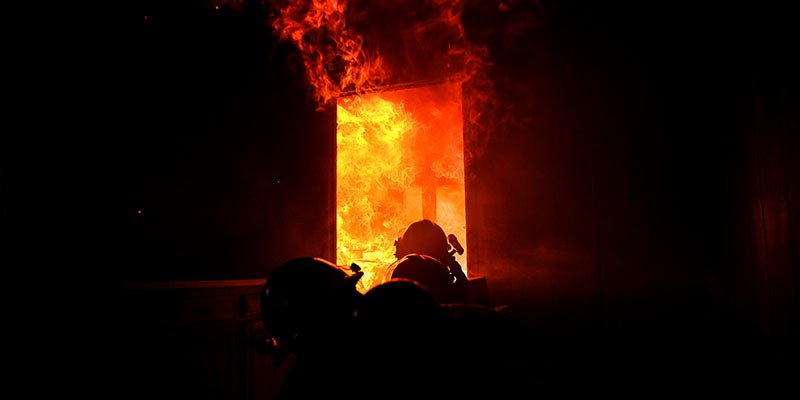
- Firefighters stage as the fire builds during a training build last Saturday for Austin and Brownsdale firefighters. Eric Johnson/photodesk@austindailyherald.com
Editor’s note: Austin Daily Herald photographer Eric Johnson was given the opportunity to experience and photograph how firefighters train for real emergencies. He not only covered the burn, but actively particpate in the training. This is his first-person account.
Early on Saturday, June 19, Austin Fire Chief Jim McCoy brought firefighters from Austin and Brownsdale together to go over the day’s plan.
Behind them was the shell of a house on a rural property located on 570th Avenue between Brownsdale and Lansing.
The day was to include four training burns before letting the home burn completely to the ground. Setup for the burn included snaking hose around the house along with stacking pallets and straw bales inside the house.
The only thing left was to suit up and start the work.
I was included in this training, but on a different scale than simply covering the burn. A couple weeks before the burn, McCoy offered me the chance to not only cover the burn and see how firefighters train, but to actively take part so I could gain a complete understanding of exactly what firefighters do and what they have to contend with.
“It gives people a new appreciation for what we do,” McCoy explained. “You understand how labor intensive it is. It’s not just as simple as spraying the water and putting the fire out. People just don’t understand what we do.”
It was an experience that I’ve come close to in the past, but never before on this intimate of a level. It was eye-opening and revealing, but it formed a new level of appreciation for the risks firefighters take.
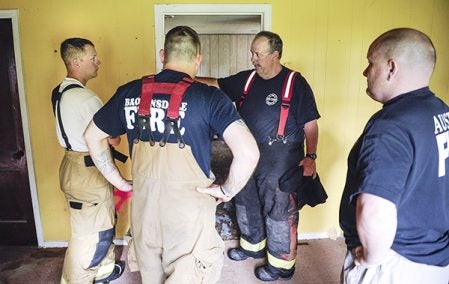
Riverland instructor and Austin firefighter Terry Peterson, second from left, does a walkthrough with Brownsdale firefighters Sam Srock, left, and Drew Hartson. Also, with them is Austin firefighter Tim Olson. Eric Johnson/photodesk@austindailyherald.com
The lead up
Over the years, I’ve been able to develop a strong relationship with the fire departments I’ve covered for a number of reasons.
Of course, it has helped in my job, gaining access that sometimes others don’t get. It’s helped me understand where I can and cannot go during an active fire scene, but it’s also allowed me a friendly rapport with the firefighters themselves.
Through those years, the departments — both in Austin and Huron, South Dakota — have given me several opportunities to see what they do through training burns, but I’ve never come this close.
Some let me stick a camera through a window or door just long enough to get something before safety required me to take a step back.
So when McCoy offered me this opportunity, there was no way I was going to say no.
It should be said, that I’ve always been interested in fire and fire departments. It’s a fascination of watching the two sides interact, and, yes, a fascination with fire itself.
There was a time just after high school where I flirted with the idea of taking up the hose, but it never came to fruition.
The Tuesday before the burn, I met McCoy at the Austin Fire Station where we talked about the burn and then drove over to Riverland Community College to get fitted for gear — turn-out gear that includes: the coat, pants, helmet, gloves and hood. The SCBA backpack would be supplied at the scene.
RCC’s firefighter program, run by Brian and Wanda Staska, works closely with Austin’s department and other departments throughout the area, with instructors being firefighters in these departments. It is a partnership, where training is concerned, a necessity.
“They provide the instructors and the paperwork,” McCoy said.
After a few minutes I had all the gear, which was stowed at the Austin Fire Department and waiting for me Saturday morning when I arrived.
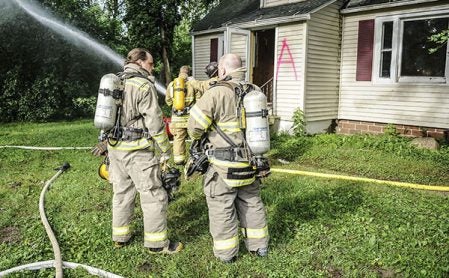
I talk with Austin firefighter Tim Olson, right, as to what I can expect and how to keep track of my air before heading in for my first-ever training burn. Photo by Michelle Marcoux
Getting ready
The firefighters met before the burn, and McCoy explained how I would fit into the grand scheme of things.
The first burn had me going in with two firefighters from Brownsdale: Drew Hartson and Sam Srock. There would be no pictures this time. Just a place on the hose as instructor and Austin firefighter Terry Peterson took us through the procedures of knocking down the fire and ventilating.
Here I have to make an admission — misguided as it is: When we first started planning this, there was an idea of excitement and enthusiasm in the back of my head. I was going to be a firefighter — at least for a morning. All ideas of training and what they actually do were nonexistence. Perhaps there was a bit of the heroic in me. Not exactly Kurt Russell from “Backdraft,” but something close.
That changes when you start putting on the equipment.
McCoy, Peterson and Tim Olson — another Austin firefighter that was assigned to make sure I didn’t get lost and that my equipment was on right — all at various points began telling me what I was going to do and what I was to expect.
At that moment, I wasn’t a journalist anymore. I was a trainee, and that was reflected in how the three explained things to me.
Hartson, Srock and I started getting ready, with Olson helping me get the SCBA unit situated and familiar with how it was used, and he explained what was going to happen after.
I can’t attest to how firefighters feel about this, but for me there is something that happens when the mask goes on for the first time.
The first thought is: “This is serious now.” But really, there is a narrowing of vision — in both the act of what you see and the task that’s ahead of you.
That last part is rammed even further home when the oxygen is flowing. This is the first and most important line of defense for firefighters. No air could mean catastrophe.
So when the mask went on and the air turned on, creating a hiss of air for every breath I took, the morning became very serious.
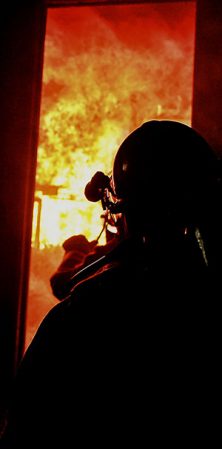
A firefighter watches the rising flames through a door in a traing burn house last Saturday. Eric Johnson/photodesk@austindailyherald.com
The flame
McCoy would later explain to me that training is still training.
“Trainingwise? Nothing,” he answered when asked about any changes in training over the years. “We’re still training the same. Fire is still fire. What’s changing is how we attack the fire.”
Technology in fire science — like all technology — has raced ahead, seemingly picking up speed at the turn of every day.
Naturally, the equipment has evolved as well, but behind that equipment is still the training — perhaps the most important aspect of fighting fires, just because of what the end result is.
“We use the information that is out there to change the way we do things,” McCoy said. “Eventually we always have to go in. Most times we have to get into the building to completely put it out.”
That’s a point easy enough to get by just talking to firefighters, but it’s impossible to fully understand unless you see the fire and how it evolves.
Before the fire was even lit, there was a sense of the seriousness involved in just this act of training. Peterson explained our roles before we were instructed to kneel on the floor, hose woven between us. I was in the middle.
At this point, I can say there was really no fear like I thought there might be. This was unknown territory for me. I had no formal training and no experience, yet all my concentration was on Peterson’s instruction. I was just a guy from a newspaper put into an extraordinary position.
Granted, that position was surrounded by firefighters — but still: It was daunting.
We knelt before what could have been a bedroom at one point. In one corner were a couple pallets with straw piled all around it.
Peterson eventually used a small propane torch and lit the straw.
I’ve seen this before but never so close. The result is always amazing and intriguing to watch. The flames build fast, consuming the straw and pallets in no time at all, eating at the walls and ceiling.
When the flames reached the ceiling, they flowed across it, not unlike the waves of an ocean. It’s terribly cliche, but the fire does appear to be alive — growing and consuming as it ate the house.
I started to feel small in the face of the billowing flames, and as the smoke began to drape around us, you start to realize just how small and dangerous the world is becoming.
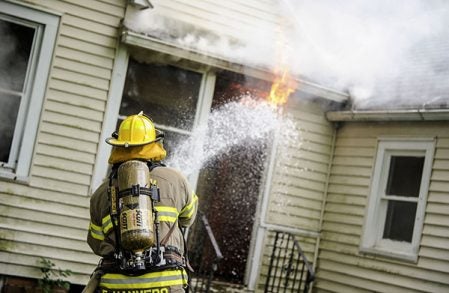
Austin firefighter Ernie Hammero puts water on flames sneaking out a back door during a training burn last Saturday. Eric Johnson/photodesk@austindailyherald.com
Smoke gathered quickly, forming two distinct layers that firefighters call either smoke layering or thermal layering. Eventually, the entire room would have filled, but at that moment the separation was plain to see. Olson’s head was enveloped where he knelt, but the rest of his body was still easily discerned.
At our level the smoke was quickly obscuring vision as it flowed from the room. First, Srock knocked the flames down, leaving some small licks to continue burning. Then it was my turn.
Equally amazing compared to the initial burn was how quickly the fire reignited and gained momentum again. Peterson led me through how to knock it down, indicating how much to open the hose and where to direct it.
We did this a couple times so all three of us got two times on the hose, before we put the fire out all together.
At this point, I got a new opportunity. Venting the room.
It’s called hydraulic ventilation. Peterson had me point the nozzle out the window and open it up. The act of the water flowing through the window creates a wind that pulls the smoke out with it. It’s a phenomena you can actually see as the smoke streams past you.
We checked for hotspots, put them out, and then we left the house and walked across the road to rehab.
Afterthoughts
At rehab, our coats, helmets, gloves and SCBAs came off. Olson stressed often to keep drinking water, which at that moment became readily obvious. It was a hot and humid morning and my shirt and pants were soaked all the way through with sweat. It was easy to see how quickly the heat could affect a firefighter.
Peterson went over some things with us afterward about how it went. I couldn’t help but notice he said several times, “That was a good fire” not in terms of fire in a burning building being a good thing, but in terms of what we were able to experience.
Both Hartson and Srock asked me what I thought, both with grins like I had just been let in on some secret.
Olson then asked, “How are you feeling?”
Physically, of course, I was tired and drained but otherwise feeling good. The equipment is bulky and cumbersome. Moving fast isn’t much of an option. At one point inside the house I had to adjust my position somewhat from a kneeling stance in order to move into the room we just burned and check for flames. Moving through a doorway no more than four-feet wide, carrying a rigid hose, in full equipment on your knees is not easy. Had it been an actual fire and something had gone wrong — I can’t attest to whether or not I could have escaped. It’s an unnerving uncertainty.
Later though, McCoy asked me, “Did you have fun?”
He wasn’t the only one. Several asked if I had fun or what I thought.
I found the answer was harder than I imagined. It was exciting and exhilarating all at once. The adrenaline was pumping and I was in definite awe of what was going on around me.
I don’t think I ever really adequately answered the question, except to say that part of me wanted to do it again.
Every time I answered with that, the firefighters I was talking to would smile.
“There’s always the sense of the unknown of what you are getting into,” McCoy said later. “You’re inside to learn, the first time is a learning experience. It’s difficult to explain what they feel after they come out. Hopefully, they come out with a better understanding of a firefighter.”
The experience of being in a building being destroyed by fire, at least for someone not accustomed to it, is surreal. I’ve covered enough fires, from the burned-food variety, to grass fires, to the utter destruction of a structure, and never once did I really stop to consider what they were doing inside and what they had to contend with.
I think I knew of course, but failed to understand. Until you have to do a job with flames revolving above you, it’s not really possible to fully understand.
“To totally understand a fire, to see how it starts and grows and how the water works, you have to get in there and see it,” McCoy said. “And that’s part of understanding.”
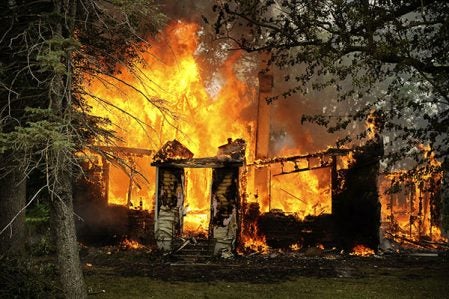
A house used for a training burn is completely engulfed. For more photos from the day go to the Austin Daily Herald’s Facebook page. Eric Johnson/photodesk@austindailyherald.com
Now I know
On the third burn, I went back in to take pictures. In that short amount of time I had an idea of what to expect but it didn’t change how I felt. A fire has a way of making you feel claustrophobic and even after experiencing it the first time, it was a lot to take in the second time.
Because of the heat, I wasn’t able to stay long with the camera, but the pictures I did get show a lot of what a firefighter could face when entering a structure.
Eventually the house was allowed to burn itself out. The heat it was putting out, even from a distance, was sometimes overwhelming and required firefighters to put water on the hoses themselves to keep them from burning.
It was a moment of retrospection for me and I was still getting questions of what I thought. At one point I wandered back to where the water was being pumped and talked to Austin firefighter Jim Halsey.
He related pointing the department’s thermal camera at the fire. In just a few short minutes he said the camera failed to represent the temperature in numbers — simply, hot.
It was clear how little time firefighters actually have in the face of an elemental force that moves so quickly. Time is always a factor and yet in the midst of all this, firefighters have a mammoth task to not only ensure the safety of those within the house and out, but themselves as well.
And this is all from a training burn of an empty, two-story dwelling in rural Mower County.
This is an opportunity I’ll never forget, along with its lessons. The training is always important, but in the end there is always more to learn.
“Firefighting is ever-changing,” McCoy said. “You will never know everything you need to know about firefighting. That’s just the way it is. It’s a dangerous profession, but the more you know the safer you are.”


